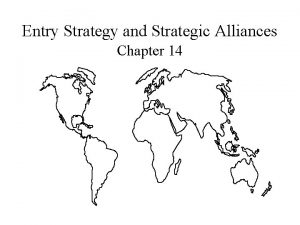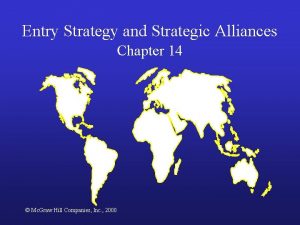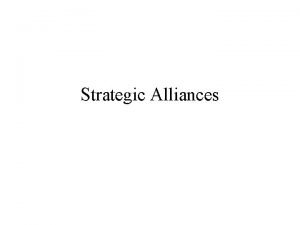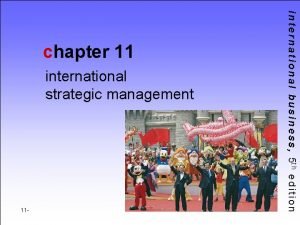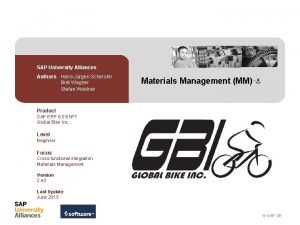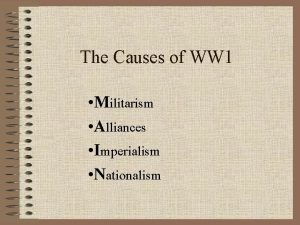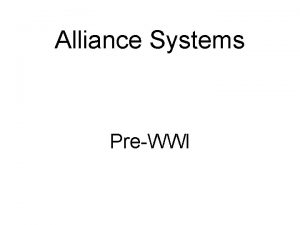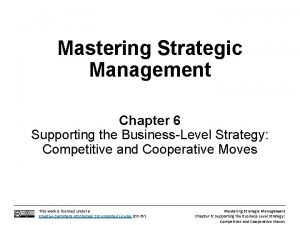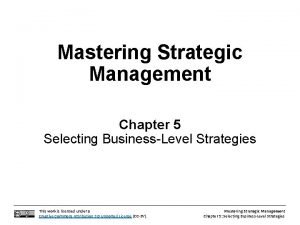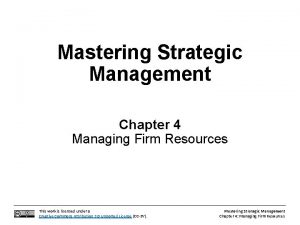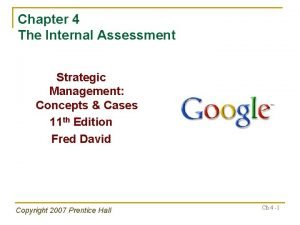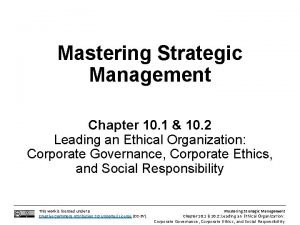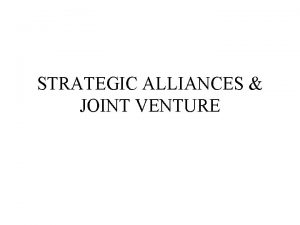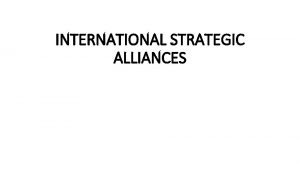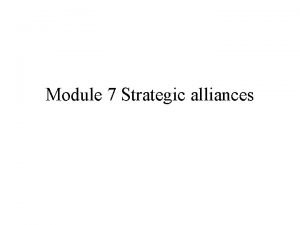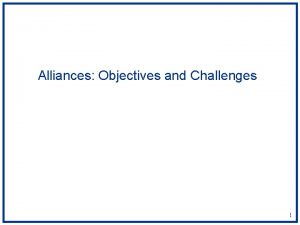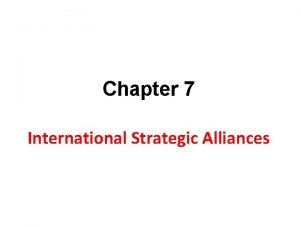Chapter 9 International Strategic Alliances Design and Management











































- Slides: 43

Chapter 9 International Strategic Alliances: Design and Management © 2013 Cengage Learning. All Rights Reserved. May not be scanned, copied or duplicated, or posted to a publicly accessible website, in whole or in part.

Learning Objectives (1 of 3) • Know the steps for implementing successful international strategic alliances. • Describe how multinational companies link value chains in international strategic alliances. • Understand the importance of choosing the right partners for alliances. • Know the important characteristics to look for in potential alliance partners. © 2013 Cengage Learning. All Rights Reserved. May not be scanned, copied or duplicated, or posted to a publicly accessible website, in whole or in part.

Learning Objectives (2 of 3) • Distinguish between equity-based international joint ventures and other types of international cooperative alliances. • Know the basic components of an international strategic alliance contract. • Understand the control systems and management structures used in alliance organizations. © 2013 Cengage Learning. All Rights Reserved. May not be scanned, copied or duplicated, or posted to a publicly accessible website, in whole or in part.

Learning Objectives (3 of 3) • Appreciate the unique problems in human resource management faced by managers in alliance organizations. • Realize the importance of interfirm commitment and trust for building successful international strategic alliances. • Understand how multinational companies assess the performance of their international strategic alliances. • Know when companies should dissolve or © 2013 Cengage Learning. All Rights Reserved. May not be scanned, copied or duplicated, or posted to a publicly accessible website, in whole or in part.

Strategic Alliance Issues • Although strategic alliances are a fast and flexible way to break into new markets, they are inherently unstable, for these reasons: • They may be poorly designed or managed. • Partnering with a company from a different nation compounds management difficulties. • Partners may disagree on how to run the business. • Even profitable alliances can be torn by © 2013 Cengage Learning. All Rights Reserved. May not be scanned, copied or duplicated, or posted to a publicly accessible website, in whole or in part.

Exhibit 9. 1: Implementing a Strategic-Alliance Strategy © 2013 Cengage Learning. All Rights Reserved. May not be scanned, copied or duplicated, or posted to a publicly accessible website, in whole or in part.

Where to Link in the Value Chain • Many benefits of strategic alliances: • Gain access to local partner’s knowledge of market, meet government requirements, share risks, share technology, economies of scale, access lower cost raw materials or labor. • Alliances combining same value-chain activities gain efficiencies, merge talents, and share risks. © 2013 Cengage Learning. All Rights Reserved. May not be scanned, copied or duplicated, or posted to a publicly accessible website, in whole or in part.

Exhibit 9. 2: Examples of Linking Value Chains in Strategic Alliances © 2013 Cengage Learning. All Rights Reserved. May not be scanned, copied or duplicated, or posted to a publicly accessible website, in whole or in part.

Exhibit 9. 3: Value-Chain Links in US International Alliances © 2013 Cengage Learning. All Rights Reserved. May not be scanned, copied or duplicated, or posted to a publicly accessible website, in whole or in part.

Choosing a Partner: The Most Important Choice? • The success or failure of a strategic alliance depends on how well the partners get along. • Especially early in the relationship, each party must believe it has a good partner who can deliver on promises and be trusted. • Picking the wrong partner can have negative major consequences. © 2013 Cengage Learning. All Rights Reserved. May not be scanned, copied or duplicated, or posted to a publicly accessible website, in whole or in part.

Key Criteria for Choosing a Partner (1 of 3) • There are several key criteria for choosing an appropriate alliance partner: • Seek strategic complementarity. • Prospective partners must understand each other’s strategic objectives, short & long term. • Pick a partner with complementary skills. • Technical complementarity is most important. • Find partners with similar but not identical products. © 2013 Cengage Learning. All Rights Reserved. May not be scanned, copied or duplicated, or posted to a publicly accessible website, in whole or in part.

Key Criteria for Choosing a Partner (2 of 3) • Seek out companies with compatible management styles. • Seek a partner that will provide the “right” level of mutual dependency; partners must rely on each other. • Avoid the “anchor” partner: • Anchor Partner: a partner that holds back the strategic alliance because it cannot or will not provide its share of the © 2013 Cengage Learning. All Rights Reserved. May not be scanned, copied or duplicated, or posted to a publicly accessible website, in whole or in part.

Key Criteria for Choosing a Partner (3 of 3) • Be cautious of the “elephant-and-ant” complex. • This occurs when two companies are greatly unequal in size. • The large firm may dominate the smaller firm. • Assess operating policy differences with potential partners. • Assess the difficulty of cross-cultural © 2013 Cengage Learning. All Rights Reserved. May not be scanned, copied or duplicated, or posted to a publicly accessible website, in whole or in part.

Exhibit 9. 4: International Strategic Alliances for Small Multinational Companies © 2013 Cengage Learning. All Rights Reserved. May not be scanned, copied or duplicated, or posted to a publicly accessible website, in whole or in part.

Choosing an Alliance Type • There are three main types of strategic alliances: • Informal international cooperative alliances • Formal international cooperative alliances (ICAs) • International joint ventures (IJVs) © 2013 Cengage Learning. All Rights Reserved. May not be scanned, copied or duplicated, or posted to a publicly accessible website, in whole or in part.

Informal International Cooperative Alliance • An Informal International Cooperative Alliance is: • A non-legally binding agreement between companies from two or more countries to cooperate. • They may be agreements of any kind, and may provide links anywhere on their value chains. • Because there is no legally-binding © 2013 Cengage Learning. All Rights Reserved. May not be scanned, copied or duplicated, or posted to a publicly accessible website, in whole or in part.

Formal International Cooperative Alliances (ICAs) • A formal International Cooperative Alliance (ICA) • Calls for high degree of involvement with partners. • Usually, a formal contract specifies what each partner will give and receive. • May require sharing proprietary information, which makes backing out of this alliance more difficult. © 2013 Cengage Learning. All Rights Reserved. May not be scanned, copied or duplicated, or posted to a publicly accessible website, in whole or in part.

International Joint Ventures (IJVs) • An International Joint Venture is a selfstanding legal entity owned by two or more parent companies from different countries; each has an equity interest. • The venture need not be equally owned. • Contributions may be cash, technology or other resources. • If there are many members, the entity is called a consortium. © 2013 Cengage Learning. All Rights Reserved. May not be scanned, copied or duplicated, or posted to a publicly accessible website, in whole or in part.

Exhibit 9. 5: Types of Alliances © 2013 Cengage Learning. All Rights Reserved. May not be scanned, copied or duplicated, or posted to a publicly accessible website, in whole or in part.

Negotiating the Agreement • Both formal ICAs and IJV require a negotiated and signed contract. • Negotiation issues include: • Products or services of the alliance • Equity contributions (cash or other resources) • Management structure • “Prenuptial” agreements regarding dissolution © 2013 Cengage Learning. All Rights Reserved. May not be scanned, copied or duplicated, or posted to a publicly accessible website, in whole or in part.

Exhibit 9. 6: Selected Questions for a Strategic -Alliance Agreement © 2013 Cengage Learning. All Rights Reserved. May not be scanned, copied or duplicated, or posted to a publicly accessible website, in whole or in part.

Organizational Design in Strategic Alliances • Design of the organization depends on the type of alliance chosen. • Informal ICAs often do not require formal design. • Formal ICAs may require a separate organizational unit housed in one company, with employees from both. • IJVs are separate legal entities, and require a separate organization to carry out the © 2013 Cengage Learning. All Rights Reserved. May not be scanned, copied or duplicated, or posted to a publicly accessible website, in whole or in part.

Decision-Making Control • There are two major areas of decision making: • Operational decisions (daily running of organization) • Strategic decisions (strategy for long term survival) • Majority owners do not necessarily control both areas. • IJVs’ strategic decision-making takes place at © 2013 Cengage Learning. All Rights Reserved. May not be scanned, copied or duplicated, or posted to a publicly accessible website, in whole or in part.

Management Structures (1 of 3) • MNCs typically use five management control structures for their ICAs or IJVs: • 1. Dominant Parent: The Dominant Parent controls strategic and operational decision making. • Often has majority ownership • Treats the IJV as its wholly owned subsidiary • 2. Shared Management: both parent companies contribute approximately the © 2013 Cengage Learning. All Rights Reserved. May not be scanned, copied or duplicated, or posted to a publicly accessible website, in whole or in part.

Management Structures (2 of 3) • MNCs typically use five management control structures for their ICAs or IJVs: (cont’d) • 3. Split Control Management: Partners usually share strategic decision making and make functional decisions independently. • 4. Independent Management: Alliance managers act more like managers from a separate company. © 2013 Cengage Learning. All Rights Reserved. May not be scanned, copied or duplicated, or posted to a publicly accessible website, in whole or in part.

Management Structures (3 of 3) • MNCs typically use five management control structures for their ICAs or IJVs: (cont’d) • 5. Rotating Management: Managers from the partners rotate through the key positions in the management hierarchy. • This structure is popular in developing countries. • It serves to trains management talent and helps to transfer expertise to the © 2013 Cengage Learning. All Rights Reserved. May not be scanned, copied or duplicated, or posted to a publicly accessible website, in whole or in part.

Choosing a Strategic Alliance Management Structure (1 of 2) • If partners have similar technologies and know-how, and contribute equally, a Shared Management structure is preferred. • If partners have different technologies but contribute equally, a Split Management structure is preferred. • If one partner has a dominant equity position, or is more important to one partner, a Dominant Management structure is more likely. © 2013 Cengage Learning. All Rights Reserved. May not be scanned, copied or duplicated, or posted to a publicly accessible website, in whole or in part.

Choosing a Strategic Alliance Management Structure (2 of 2) • For joint ventures in particular: • Mature joint ventures move to independent structures as the joint venture’s management team gains more expertise. • Joint ventures in countries with a high degree of government intervention produce IJVs with local partner dominance. • Independent management structures are more likely when the market is expanding, the venture does not require much capital, or the venture does not require much R&D input from its © 2013 Cengage Learning. All Rights Reserved. May not be scanned, copied or duplicated, or posted to a publicly accessible website, in whole or in part.

Commitment and Trust: The Soft Side of Alliance Management • Managers from both failed and successful strategic alliances advise the importance of building mutual trust and commitment among partners from the beginning. • Commitment: taking care of each other and putting forth extra effort to make the venture work • Attitudinal commitment: Willingness to dedicate resources and efforts and face risks to make the alliance work. © 2013 Cengage Learning. All Rights Reserved. May not be scanned, copied or duplicated, or posted to a publicly accessible website, in whole or in part.

Commitment and Trust: The Soft Side of Alliance Management • If alliance partners demonstrate these aspects of commitment, the venture will develop based on the principles of Fair Exchange. • Fair Exchange: Fair exchange occurs when partners believe that they receive benefits from the relationship equal to their contributions. © 2013 Cengage Learning. All Rights Reserved. May not be scanned, copied or duplicated, or posted to a publicly accessible website, in whole or in part.

Calculative Commitment • Commitment also has a practical side: • Calculative Commitment: comes from the evaluations, expectations, and concerns about the future potential for gaining rewards from the relationship. • Businesses require tangible outcomes for a relationship to continue. • A study of commitment in IJVs suggests that commitment increases when both partners © 2013 Cengage Learning. All Rights Reserved. May not be scanned, copied or duplicated, or posted to a publicly accessible website, in whole or in part.

Trust • Trust and Commitment go hand in hand. • Credibility Trust: the confidence that the partner has the intent and ability to meet promised obligations and commitments. • Benevolent Trust: the confidence that the partner will behave with goodwill and with fair exchange. • The development of trust between alliance partners may take time. © 2013 Cengage Learning. All Rights Reserved. May not be scanned, copied or duplicated, or posted to a publicly accessible website, in whole or in part.

Exhibit 9. 7: The Trust/Commitment Cycle © 2013 Cengage Learning. All Rights Reserved. May not be scanned, copied or duplicated, or posted to a publicly accessible website, in whole or in part.

Why Is Trust Important? • Successful cooperation requires alliance partners to contribute quality inputs to the organization. • When there is no trust, partners hold back or take unfair advantage of each other, making failure likely. • Formal contracts can never identify all issues that will arise, so a trusting relationship is necessary. © 2013 Cengage Learning. All Rights Reserved. May not be scanned, copied or duplicated, or posted to a publicly accessible website, in whole or in part.

Building and Sustaining Trust and Commitment • To build and sustain trust and commitment, Multinational managers should consider key factors: • • Pick your partner carefully. Know each side’s strategic goals. Seek win-win situations. Go slowly. Invest in cross-cultural training. Invest in direct communication. Find the right levels of trust and commitment. © 2013 Cengage Learning. All Rights Reserved. May not be scanned, copied or duplicated, or posted to a publicly accessible website, in whole or in part.

Exhibit 9. 8: The “Right” Levels of Trust and Commitment © 2013 Cengage Learning. All Rights Reserved. May not be scanned, copied or duplicated, or posted to a publicly accessible website, in whole or in part.

Assessing the Performance of an International Strategic Alliance • If the strategic intent is to produce immediate results, use standard financial and efficiency measures. • Some strategic alliances provide indirect strategic benefits, but may never generate profits. • To assess IJV and ICA performance, criteria other than financials must be included, such as organizational learning, and subjective measures like alliance satisfaction and © 2013 Cengage Learning. All Rights Reserved. May not be scanned, copied or duplicated, or posted to a publicly accessible website, in whole or in part.

Exhibit 9. 9: Selected Performance Criteria for Strategic Alliances © 2013 Cengage Learning. All Rights Reserved. May not be scanned, copied or duplicated, or posted to a publicly accessible website, in whole or in part.

If the Alliance Does Not Work (1 of 2) • If an alliance does not work, there are two choices: • Improve implementation, or • Negotiate an end • Know when to quit and when to invest more. • Avoid “escalation of commitment: ” • Managers continue in an alliance longer than necessary because of past financial and emotional investments. © 2013 Cengage Learning. All Rights Reserved. May not be scanned, copied or duplicated, or posted to a publicly accessible website, in whole or in part.

If the Alliance Does Not Work (2 of 2) • Plan the end at the beginning. • Create “prenuptial agreements” at the start of the venture in which the partners decide how to terminate the alliance. • The advantage of the “prenuptial” is that negotiation takes place at a positive and friendly stage. • Recognize that death of the venture does not always mean failure. • Many alliances are short term. © 2013 Cengage Learning. All Rights Reserved. May not be scanned, copied or duplicated, or posted to a publicly accessible website, in whole or in part.

Dedicated Strategic Alliance Units • Alliances are so common that firms are developing Strategic Alliance Units to manage their design. They provide processes and procedures that help managers: • Identify the need for an alliance • Evaluate partners • Negotiate agreements • Structure the alliance organizations © 2013 Cengage Learning. All Rights Reserved. May not be scanned, copied or duplicated, or posted to a publicly accessible website, in whole or in part.

Key Lessons from Cross-Border Alliances • Understand appreciate business and cultural differences. • Keep strong executive support • Communicate. • Practice commitment, trust and dedication. • Have “checkpoints” as the alliance is being implemented. • Review the alliance’s viability. © 2013 Cengage Learning. All Rights Reserved. May not be scanned, copied or duplicated, or posted to a publicly accessible website, in whole or in part.

Summary • The use of international strategic alliances continues to grow in international business. • Chapter 9 provides a solid understanding of the basics and how to manage strategic alliances. • Strategic alliances are prone to failure and great effort must be taken to make them successful. © 2013 Cengage Learning. All Rights Reserved. May not be scanned, copied or duplicated, or posted to a publicly accessible website, in whole or in part.
 Entry strategy and strategic alliances
Entry strategy and strategic alliances Non equity alliance
Non equity alliance Entry strategy and strategic alliances
Entry strategy and strategic alliances Entry strategy and strategic alliances
Entry strategy and strategic alliances Motivation for strategic alliances
Motivation for strategic alliances Industrial organization model of above average returns
Industrial organization model of above average returns Analysing the 6 strategic options megxit
Analysing the 6 strategic options megxit Global and international issues in strategic management
Global and international issues in strategic management Alliances and acquisitions
Alliances and acquisitions Global international issues in strategic management
Global international issues in strategic management Mention the international strategic compulsions
Mention the international strategic compulsions International strategic management process
International strategic management process Imperialism wwi definition
Imperialism wwi definition Cost of world war 1
Cost of world war 1 Types of functional alliances
Types of functional alliances Doctrines et alliances
Doctrines et alliances Who was in ww1
Who was in ww1 Berlin wall
Berlin wall Sector skills alliances
Sector skills alliances Sap material master data
Sap material master data Alliance ww1 cartoon
Alliance ww1 cartoon Militarism alliances imperialism nationalism
Militarism alliances imperialism nationalism Designed alliances
Designed alliances Strategic complements example
Strategic complements example Strategic fit vs strategic intent
Strategic fit vs strategic intent Chapter 11 strategic cost management
Chapter 11 strategic cost management Strategic management chapter 6
Strategic management chapter 6 Strategic management chapter 5
Strategic management chapter 5 Strategic management chapter 4
Strategic management chapter 4 Chapter 1 the nature of strategic management
Chapter 1 the nature of strategic management Strategic management
Strategic management Chapter 7 strategic management
Chapter 7 strategic management Chapter 7 strategic management
Chapter 7 strategic management Implementing strategies: management and operations issues
Implementing strategies: management and operations issues Strategic management chapter 6
Strategic management chapter 6 Integrating strategy and culture in internal assessment
Integrating strategy and culture in internal assessment Chapter 3 planning
Chapter 3 planning Strategic management chapter 7
Strategic management chapter 7 Implement strategies management issues
Implement strategies management issues What is external audit in strategic management
What is external audit in strategic management Strategic management chapter 10
Strategic management chapter 10 Strategic cost management chapter 1
Strategic cost management chapter 1 Chapter 2 strategic management
Chapter 2 strategic management Establish accurate controls
Establish accurate controls
